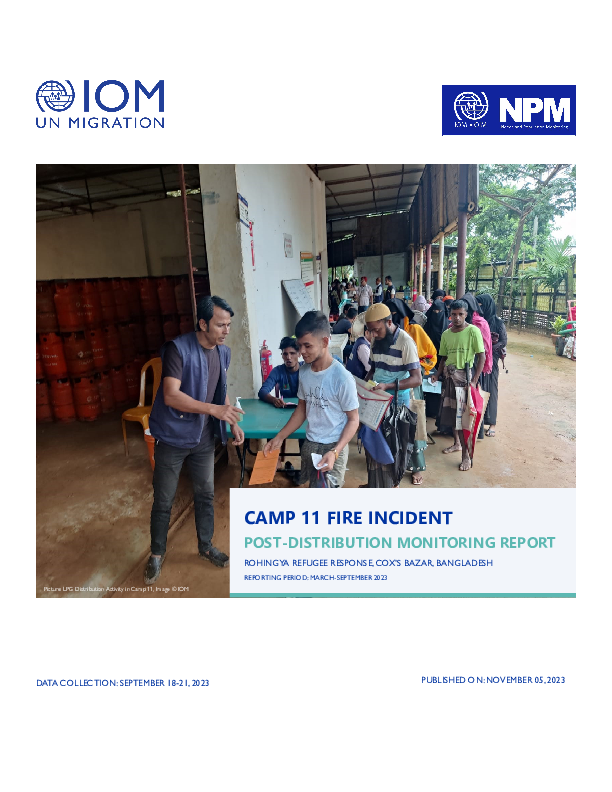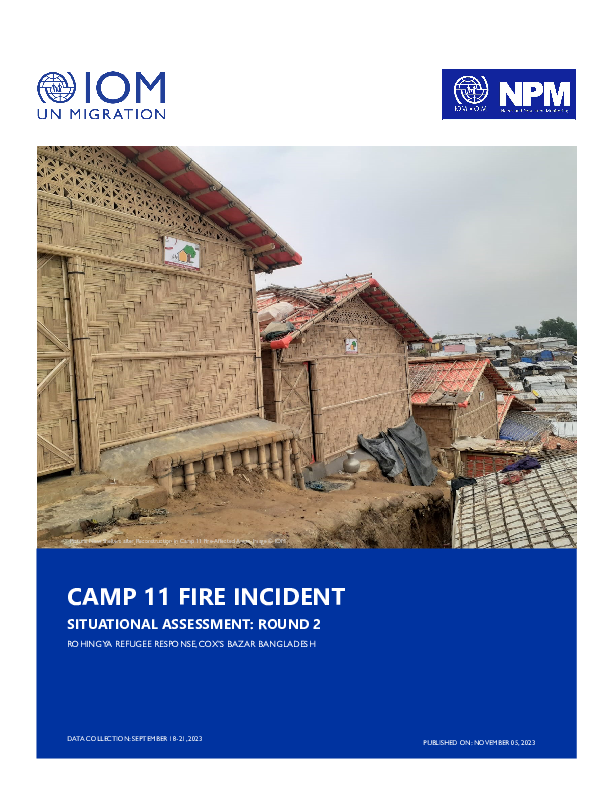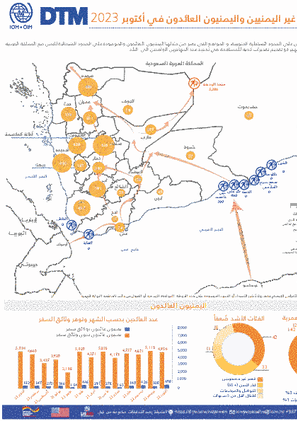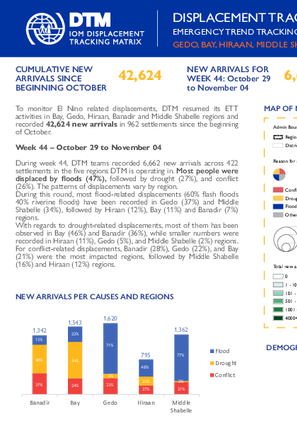-
Countries
-
Data and Analysis
-
Special Focus
-
Crisis Responses

Contact
NPM Bangladesh, npmbangladesh@iom.int
Language
English
Location
Bangladesh
Period Covered
Mar 01 2023
Sep 30 2023
Activity
- Survey
- Community Perception
The world’s largest refugee camp suffered significant damage in certain areas across Camp 11 after a massive fire spread through this camp on March 5, 2023. Three blocks were affected blocks (A, B, and D), with Block D having the most impacted households (1,278). The fire caused to a huge number of shelter damage (2,165 shelters) and the temporary displacement of five thousand people. IOM redirected efforts to support individuals impacted by the fire by deploying staff and resources quickly and remaining present in the camp without interruption.
Moreover, IOM’s Needs and Population Monitoring (NPM) team conducted an Initial Rapid Needs Assessment1 within 24 hours of the incident to provide immediate response and an In-depth Rapid Needs Assessment2 within 48 hours to support effective decision-making processes in meeting the needs of the affected population. In addition, in order to assess and provide an overview of the situation and humanitarian services and gaps, as well as to understand the driver and severity of needs of the affected population from each sector’s perspectives and to know the sufficiency and effectiveness of the assistance provided to the affected households, NPM conducted a household level situational assessment3 in June 2023.
Six months later the fire incident, NPM conducted post-distribution monitoring (PDM) to ascertain the beneficiaries ’ satisfaction and opinions regarding the quality, sufficiency, and effectiveness of the assistance that had been provided to them by various units over the last six months.

Contact
NPM Bangladesh, npmbangladesh@iom.int
Language
English
Location
Bangladesh
Period Covered
Sep 18 2023
Sep 21 2023
Activity
- Survey
- Community Perception
The massive fire that swept through Camp 11 on March 5, 2023, affecting over 16,000 Rohingya refugees, severely damaged certain areas of the world’s largest refugee camps. Of these, 5,000 Rohingya refugees were temporarily displaced and moved to nearby camps. The fire destroyed 2,165 shelters and affected many refugees who were left with nothing. Three blocks were affected with Block D having the most affected households (1,278). IOM in close coordination with local authorities and the fire brigade immediately dispatched the response teams right away to help the refugees and control the situation. IOM redirected efforts to assist those affected by the fire through rapid deployment of staff, and resources, and uninterrupted presence in the camps.
Moreover, IOM’s Needs and Population Monitoring team conducted Initial Rapid Needs Assessment1 within 24 hours to provide immediate response and In-depth Rapid Needs Assessment2 within 48 hours to support effective decision-making processes in meeting the needs of the affected population.
In addition, three months after the incident in June 2023 NPM conducted the household-level situational assessment3 in order to assess and provide an overview of the current situation and humanitarian services and gaps, as well as to understand the driver and severity of needs of the affected population from each sector’s perspectives and to know the sufficiency and effectiveness of the assistance provided to the affected households. Currently, six months after the fire incident, NPM carried out another situational assessment with similar objectives, including identifying any change to access various services and assistance they have been receiving since the fire incident. This report presents the overall findings of the second-round situation assessment.

Contact
DTMMozambique@iom.int
Language
English
Location
Mozambique
Period Covered
Nov 10 2023
Nov 12 2023
Activity
- Mobility Tracking
- Event Tracking
Between 10 and 12 November 2023, attacks and fear of attacks by Non-State Armed Groups in Macomia district (Litandacua and Novo Cabo Delgado localities) triggered 801 individual displacements within the district. Reported families have taken shelter within resettlement sites and host communities in Changane, Nanga A, and Napulubo bairros.
Assessments team record 139 families/520 individuals displaced within Nanga A Relocation Site alone. An estimate of 35 Internally Displaced Persons (IDPs) have been identified with vulnerabilities. An estimated 439 were children under 18 years old. Owing to prevailing security concerns reported by displaced families, intentions on duration of their stay in sites and host communities remains uncertain. Movements in the region continue to be dynamic between Chai posto and Macomia Sede. The objective of the Emergency Tracking Tool (ETT) - Movement Alert is to collect information on large and sudden population movements, and to provide support to the humanitarian response partners by
disseminating data on IDPs to support effective humanitarian response to the affected population. Information is collected through key informants interviews or direct observation. This alert provides basic information on displacements, and additional information can be shared upon request.

Contact
Niger Migration Data and Research Unit - nigerdataresearch@iom.int
Language
French
Location
Niger
Period Covered
Mar 01 2023
Mar 31 2023
Activity
- Survey
La région de Diffa, dans le bassin du lac Tchad, est confrontée à une grave crise humanitaire due au conflit en cours et aux attaques de groupes armés. Cela a entraîné d'importants déplacements de population et une détérioration des conditions de vie. Les déplacés internes, les réfugiés et les communautés hôtes font face à des défis majeurs tels que l'accès limité à l'eau potable, à la nourriture, aux soins de santé et à l'éducation. Les organisations humanitaires travaillent activement pour répondre à ces besoins urgents, en fournissant une aide vitale, en soutenant les infrastructures locales et en protégeant les droits des personnes touchées. Cependant, la situation demeure préoccupante et nécessite une attention continue et des ressources supplémentaires pour atténuer les souffrances et trouver des solutions durables.
Afin de trouver des solutions durables aux déplacements internes et de prévenir de nouveaux déplacements dans la région, il est essentiel de comprendre les niveaux de stabilité dans les lieux accueillant les populations déplacées. L'OIM a lancé l'Indice de solution et de mobilité (ISM) en 2019 pour évaluer la stabilité des zones accueillant les rapatriés ou les populations déplacées dans le bassin du lac Tchad (BCL). Cet indice vise à identifier les facteurs influençant la stabilité d'un lieu afin de déterminer les interventions prioritaires pour la transition et le rétablissement, en renforçant la résilience et la stabilité dans une région marquée par les conflits et les déplacements. L’ISM mesure les perceptions de stabilité et analyse les facteurs qui influencent les décisions des populations de rester ou de se déplacer. Il offre un outil permettant aux autorités et aux partenaires de développer de meilleures stratégies, de prioriser les ressources et de planifier les interventions dans les zones fragiles et instables, en intégrant les approches humanitaires, de relèvement et de stabilisation. Ce rapport présente les résultats du quatrième cycle de collecte de données de l'Indice de solution et de mobilité réalisé entre le 4 et le 23 mars 2023 dans la région de Diffa, au Niger.
Contact
iomyemendtm@iom.int
Location
Yemen
Activity
- Flow Monitoring
Period Covered
Oct 01 2023 -Oct 31 2023
IOM Yemen DTM’s Flow Monitoring Registry (FMR) monitors migrant arrivals on the southern coastal border and Yemeni return locations on Yemen's northern border with the Kingdom of Saudi Arabia (KSA). Enumerators placed at Flow Monitoring Points (FMPs) record migrant arrivals and returning Yemeni nationals to identify different patterns of migration, and to provide quantitative estimates to help define the population of irregular migrants entering the country. FMR is not representative of all flows in Yemen and should be understood as only indicative of migration trends of the unknown total number of migrants arriving in Yemen at FMPs during the time frame indicated. Access constraints limit the ability to collect data at some migrant arrival points.
-
In October 2023, IOM Yemen DTM recorded 1,169 migrants entering Yemen, a decrease of 25 per cent compared to last month (1,551). Since the joint military campaign began three months ago, the number of migrants entering Yemen through the coast of Lahj has been steadily decreasing. The decrease reached its highest point in October (-100%) when there were no reported migrants entering Yemen via this route. In August (2,249) and September (548) reported notable decreases, and this trend continued into October in which no migrants were recorded as arrival to Yemen from Djibouti. During the campaign, military points on the coastal strip were deployed to pursue smugglers’ boats, arrest smugglers who assisted in transporting migrants, and raid their properties. The campaign is still ongoing in Lahj governorate that used to receive high number of migrants from Djibouti before August 2023.
-
In contrast, the number of migrants entering Shabwah has slightly increased by 17 per cent in October (1,169) compared to September (1,003). It is believed that this number would have significantly increased had the Tropical Cyclone "Tej," not made landfall, which caused instability in the sea weather conditions, and brought heavy rains and strong winds causing flooding and damage to infrastructure to different governorates in Yemen including Shabwah.
According to DTM, conflict-induced movements constituted 78 per cent of all incoming movements in October 2023. These movements were exclusively observed in Shabwah, originating from Bari, Somalia (26% children, 19% women, and 55% men).
-
The humanitarian crisis in Yemen and challenges in reaching Saudi Arabia led many migrants to return to the Horn of Africa. In October 2023, Djibouti DTM team recorded 588 migrants (567 male and 21 female) embarked on a dangerous journey back home by boat from Yemen. Additionally, DTM observed an increase in Yemeni returnees by eight per cent in October (5,386) compared to September (5,007). Between January and September 2023, DTM recorded a total of 93,526 migrants and 45,464 Yemeni migrant returnees to Yemen.
Population Groups
Survey Methodology
Unit of Analysis Or Observation
Type of Survey or Assessment
Keywords
Geographical Scope
Administrative boundaries with available data
The current dataset covers the following administrative boundaries

Contact
DTM Yemen, DTMYemen@iom.int
Language
English
Location
Yemen
Period Covered
Oct 01 2023
Oct 31 2023
Activity
- Flow Monitoring
تعمل مصفوفة تتبُع النزوح الخاصة بالمنظمة الدولية للهجرة في اليمن عبر سجل مراقبة التدفق في المواقع الرئيسية التي يصل عبرها المهاجرون على الحدود الساحلية الجنوبية، و المواقع التي يعبر من خلالها اليمنيون العائدون والموجودة على الحدود الشمالية لليمن مع المملكة العربية السعودية. يُراقب الباحثون المتمركزون في نقاط رصد تدفق وصول المهاجرين والمواطنين اليمنيين العائدين من أجل التعرف على الأنماط المختلفة للهجرة وتقديم تقديرات كمية للمساهمة في تحديد عدد المهاجرين الوافدين الى البلد لا يشمل سجل مراقبة التدفق جميع نقاط التدفق في اليمن، ولكنه يمثل مؤشراً حول اتجاهات الهجرة بالنسبة لإجمالي العدد غير المعروف للمهاجرين الوافدين إلى اليمن عبر نقاط التدفق خلال الإطار الزمني المحدد. والجدير بالذكر أن القيود المفروضة على الوصول تَحُد من القدرة على جمع البيانات في بعض نقاط وصول المهاجرين .
في أكتوبر 2023، سجلت مصفوفة تتبع النزوح التابعة للمنظمة الدولية للهجرة في اليمن دخول 1,169 مهاجرًا إلى اليمن، بانخفاض قدره 25 بالمائة مقارنة بالشهر الماضي (1,551). منذ بدء الحملة العسكرية المشتركة قبل ثلاثة أشهر، انخفض عدد المهاجرين الذين يدخلون اليمن عبر ساحل لحج بشكل ملحوظ. وصل الانخفاض إلى أعلى نقطة له في أكتوبر (-100٪) عندما لم يتم الإبلاغ عن دخول مهاجرين إلى اليمن عبر هذا الطريق. وفي أغسطس (2,249) وسبتمبر (548) تم الإبلاغ عن انخفاضات ملحوظة، واستمر هذا الاتجاه حتى أكتوبر حيث لم يتم تسجيل أي مهاجرين قادمين إلى اليمن من جيبوتي. وانتشرت خلال الحملة نقاط عسكرية على الشريط الساحلي لملاحقة قوارب المهربين، واعتقال المهربين الذين ساعدوا في نقل المهاجرين، ومداهمة ممتلكاتهم. ولا تزال الحملة مستمرة في محافظة لحج التي كانت تستقبل أعداداً كبيرة من المهاجرين من جيبوتي قبل أغسطس 2023. وفي المقابل، ارتفع عدد المهاجرين الذين دخلوا شبوة بشكل طفيف بنسبة 17 بالمائة في أكتوبر (1,169) مقارنة بسبتمبر (1,003). ويعتقد أن هذا العدد كان سيرتفع بشكل كبير لولا وصول الإعصار المداري "تيج" إلى اليابسة، والذي تسبب في عدم استقرار الأحوال الجوية البحرية، وتسبب في هطول أمطار غزيرة ورياح قوية تسببت في فيضانات وأضرار في البنية التحتية لمختلف محافظات اليمن بما في ذلك شبوة.
وفقًا لمصفوفة تتبع النزوح، شكلت الحركات الناجمة عن النزاع 78% من جميع الحركات الواردة في أكتوبر 2023. وقد لوحظت هذه الحركات حصريًا في شبوة، مصدرها باري بالصومال (26% أطفال، 19% نساء، و55% رجال).
أدت الأزمة الإنسانية في اليمن وتحديات الوصول إلى المملكة العربية السعودية إلى عودة العديد من المهاجرين إلى القرن الأفريقي. في أكتوبر 2023، سجل فريق مصفوفة تتبع النزوح في جيبوتي 588 مهاجرًا (567 ذكرًا و21 أنثى) انطلقوا في رحلة خطيرة للعودة إلى وطنهم بالقارب من اليمن. بالإضافة إلى ذلك، لاحظت مصفوفة تتبع النزوح زيادة في عدد العائدين اليمنيين بنسبة ثمانية بالمائة في أكتوبر (5,386) مقارنة بشهر سبتمبر (5,007). بين يناير وسبتمبر 2023، سجلت مصفوفة تتبع النزوح إجمالي 93,526 مهاجرًا و45,464 مهاجرًا يمنيًا عائدًا إلى اليمن.

Contact
DTM Yemen, DTMYemen@iom.int
Language
English
Location
Yemen
Period Covered
Oct 01 2023
Oct 31 2023
Activity
- Flow Monitoring
- Mobility Tracking
- Baseline Assessment
IOM Yemen DTM’s Flow Monitoring Registry (FMR) monitors migrant arrivals on the southern coastal border and Yemeni return locations on Yemen's northern border with the Kingdom of Saudi Arabia (KSA). Enumerators placed at Flow Monitoring Points (FMPs) record migrant arrivals and returning Yemeni nationals to identify different patterns of migration, and to provide quantitative estimates to help define the population of irregular migrants entering the country. FMR is not representative of all flows in Yemen and should be understood as only indicative of migration trends of the unknown total number of migrants arriving in Yemen at FMPs during the time frame indicated. Access constraints limit the ability to collect data at some migrant arrival points.
In October 2023, IOM Yemen DTM recorded 1,169 migrants entering Yemen, a decrease of 25 per cent compared to last month (1,551). Since the joint military campaign began three months ago, the number of migrants entering Yemen through the coast of Lahj has been steadily decreasing. The decrease reached its highest point in October (-100%) when there were no reported migrants entering Yemen via this route. In August (2,249) and September (548) reported notable decreases, and this trend continued into October in which no migrants were recorded as arrival to Yemen from Djibouti. During the campaign, military points on the coastal strip were deployed to pursue smugglers’ boats, arrest smugglers who assisted in transporting migrants, and raid their properties. The campaign is still ongoing in Lahj governorate that used to receive high number of migrants from Djibouti before August 2023.
In contrast, the number of migrants entering Shabwah has slightly increased by 17 per cent in October (1,169) compared to September (1,003). It is believed that this number would have significantly increased had the Tropical Cyclone "Tej," not made landfall, which caused instability in the sea weather conditions, and brought heavy rains and strong winds causing flooding and damage to infrastructure to different governorates in Yemen including Shabwah.
According to DTM, conflict-induced movements constituted 78 per cent of all incoming movements in October 2023. These movements were exclusively observed in Shabwah, originating from Bari, Somalia (26% children, 19% women, and 55% men).
The humanitarian crisis in Yemen and challenges in reaching Saudi Arabia led many migrants to return to the Horn of Africa. In October 2023, Djibouti DTM team recorded 588 migrants (567 male and 21 female) embarked on a dangerous journey back home by boat from Yemen. Additionally, DTM observed an increase in Yemeni returnees by eight per cent in October (5,386) compared to September (5,007). Between January and September 2023, DTM recorded a total of 93,526 migrants and 45,464 Yemeni migrant returnees to Yemen.

Contact
DTM Somalia, IOMSomaliaDTM@iom.int
Language
English
Location
Somalia
Period Covered
Oct 29 2023
Nov 04 2023
Activity
- Mobility Tracking
- Event Tracking
In response to the Somalia’s severe drought beginning in November 2021, DTM Somalia launched an Emergency Trends Tracking (ETT) tool first in Gedo and Bay regions in 2022, and subsequently in Hiraan, Banadir and Middle Shabelle regions in 2023 to monitor drought related displacement trends and hotspots in support of operational planning. However, during the first half of 2023, conflict and flooding displacements have been significant. Therefore, DTM restructured its ETT tool to capture multi-shock displacements (drought, flood, conflict and other) from October 2023.
ETT is a crisis-based tool that tracks sudden displacement triggered by specific events or emerging crises. The objective of ETT is to help prioritize humanitarian response and to enable partners to deliver rapid assistance.
Contact
DTM Somalia Location
Somalia
Activity
- Mobility Tracking
- Event Tracking
Period Covered
Oct 07 2023 -Feb 21 2024
In response to the Somalia’s severe drought beginning in November 2021, DTM Somalia launched an Emergency Trends Tracking (ETT) tool first in Gedo and Bay regions in 2022, and subsequently in Hiraan, Banadir and Middle Shabelle regions in 2023 to monitor drought related displacement trends and hotspots in support of operational planning. However, during the first half of 2023, conflict and flooding displacements have been significant. Therefore, DTM restructured its ETT tool to capture multi-shock displacements (drought, flood, conflict and other) from October 2023. ETT is a crisis-based tool that tracks sudden displacement triggered by specific events or emerging crises. The objective of ETT is to help prioritize humanitarian response and to enable partners to deliver rapid assistance.
Population Groups
IDPs
Survey Methodology
Unit of Analysis Or Observation
Admin Area 2
Admin Area 3
Site or Location
Type of Survey or Assessment
Key Informant
Keywords
Geographical Scope Partial Coverage
Administrative boundaries with available data
The current dataset covers the following administrative boundaries

Contact
DTM Peru, IOMDTMPeru@iom.int
Language
Spanish
Location
Peru
Period Covered
Sep 06 2023
Sep 29 2023
Activity
- Flow Monitoring
En el mes de setiembre, periodo de análisis, el control y vigilancia en las fronteras de Tumbes y Tacna, ubicadas al norte y sur del Perú, se vieron reforzadas por la Policía Nacional del Perú. En la frontera norte (Tumbes), incrementó la presencia policial del lado peruano y ecuatoriano tras el desarticulamiento de organizaciones criminales que operaban en el país, en la modalidad de trata de personas, tráfico de migrantes, tráfico ilícito de sustancias y otros; esto bajo un acuerdo de cooperación con Ecuador. Por el lado sur del país (Tacna), a mitad del mes de setiembre, 180 agentes policiales custodiaron múltiples puntos de entrada para impedir entradas irregulares de refugiados y migrantes a territorio peruano, y hacia fines de setiembre, más de 100 refugiados y migrantes bloquearon durante varias horas las vías que conectan Chile y Perú a modo de protesta por el impedimento de entrada a Perú al no cumplir con la documentación regular.
